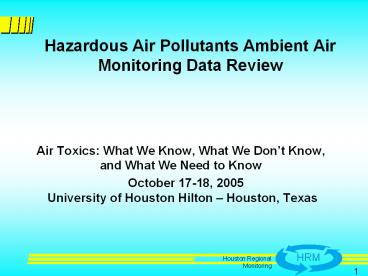Hazardous Air Pollutants Ambient Air Monitoring Data Review - PowerPoint PPT Presentation
1 / 18
Title:
Hazardous Air Pollutants Ambient Air Monitoring Data Review
Description:
Hazardous Air Pollutants Ambient Air Monitoring Data Review Air Toxics: What We Know, What We Don t Know, and What We Need to Know October 17-18, 2005 – PowerPoint PPT presentation
Number of Views:208
Avg rating:3.0/5.0
Title: Hazardous Air Pollutants Ambient Air Monitoring Data Review
1
Hazardous Air Pollutants Ambient Air Monitoring
Data Review
- Air Toxics What We Know, What We Dont Know, and
What We Need to Know - October 17-18, 2005 University of Houston
Hilton Houston, Texas
2
Houston Regional Monitoring Network
- Houston Regional Monitoring (HRM)
- A voluntary industry consortium
- Operates an ambient air quality-monitoring
network in the Houston ship channel area - Continuous criteria pollutant data collected for
past 24 years, - Periodic (24 hour composite samples, every 6th
day) VOC data collected for past 18 years - Data gathered and reported to date are effective
in assessing long-term trends for specific
pollutants
3
Houston Area Air Monitors
- Houston ranks 1 in the number of air monitors in
the nation - There are 48 ozone monitors in the
Houston-Galveston-Brazoria (HGB) area operated by
the TCEQ, City, Harris County, HRM, and other
independent sources - There are 32 monitors that measure hazardous air
pollutants (HAPs) in HGB
4
Sampling and Analytical Methodology
- HRM routinely samples for 157 VOCs at seven sites
in Houston Ship Channel - 24-hour time averaged canister VOC samples are
collected once every 6th day - Samples are analyzed by EPA TO-15
- Samples are analyzed by gas chromatography/mass
spectroscopy - To date over 9,000 samples have been collected
and reported
5
HGB HAP Monitors
Legend TCEQ EISM sites HRM sites
6
(No Transcript)
7
Benzene marginally exceeds the annual ESL at a
single site in the HRM Network
ESL Based on Odor
8
How does Houstons air compare to that of other
cities for selected compounds?
9
(No Transcript)
10
(No Transcript)
11
(No Transcript)
12
(No Transcript)
13
How Are 1,3-Butadiene Levels Trending in the
Houston Ship Channel?
14
Annual Median 1,3-Butadiene Concentration at HRM
Sites
Annual Medians have declined below 1 ppb-V since
2002
15
Annualized 1,3 Butadiene Reduction Trend Over
10-Year Period (1995-2004)
Annualized trend based on linear regression
model
16
Comparison of HRM and TCEQ Annual Mean
1,3-Butadiene Concentrations in Houston Compared
to Trends from Other US Cities (1-01-01-03
through 12-31-03) EPA AIRData
17
Observations and Conclusions
- Houston industry working in concert with the TCEQ
has been active in collecting long-term (high
quality) measurements to assess community
exposure - There are over 30 HAP monitors currently
operating in the Greater Houston Metropolitan
area making this area the most heavily monitored
area for hazardous air pollutants in the US - It is expected that emissions of HRVOC and
associated HAPs will continue to decline in
Houston as new rules are phased in to meet the
8-hour Ozone standard - Long-term measurements of air toxics are expected
to continue in order to address questions with
regard to community health - HRM will continue to do its part to provide high
quality data to better understand air quality
issues in the region - Houstons air quality has dramatically improved
and will continue to improve
18
http//www.houstonairquality.com































